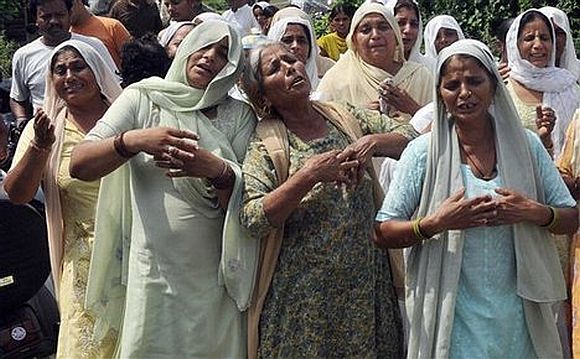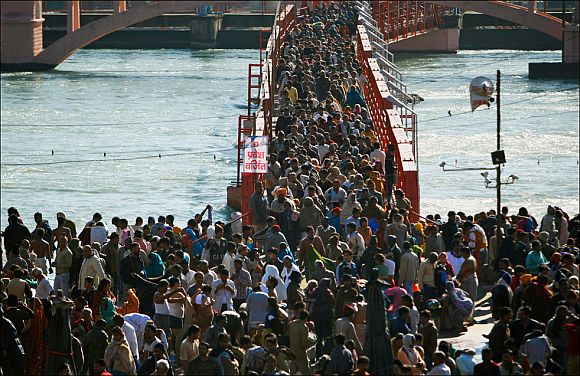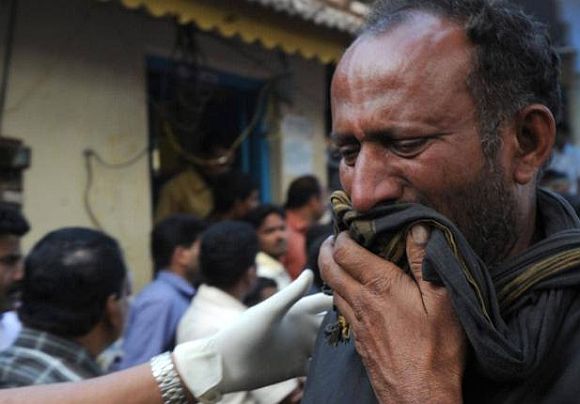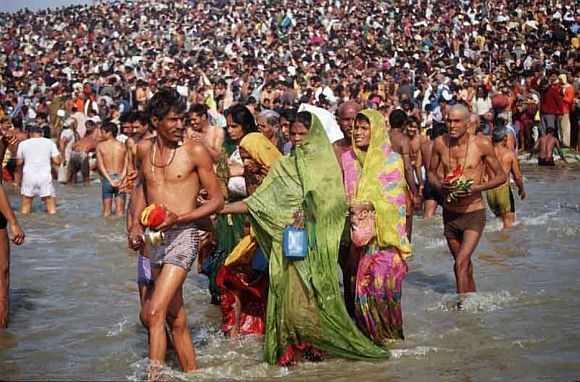A stampede at the Bhavnath Temple's annual Mahashivratri fair in Junagadh left six pilgrims dead and over 40 injured on Sunday night.
Stampedes at temples and other religious places in India have claimed nearly 1,000 lives in the last 10 years in the country.
Rediff.com takes a look at the incidents of the past:
Sixteen people were killed in a stampede that took place in Shanti Kunj Ashram in Haridwar on November 8.
Nearly five lakh people had assembled to commemorate the birth centenary of Pandit Shri Ram Sharma at the Gayatri Mahakumbh in Shanti Kunj when the stampede took place.
Click on NEXT to go further...
10 temple stampedes India won't forget
January 14, 2011: A huge melee at the famed Sabarimala shrine in Kerala killed more than 104 devotees.
More than 60 people were also injured in the stampede, which happened when a jeep crashed into homebound pilgrims at Pulmedu, a remote area in Kerala's Idukki district.
Click on NEXT to go further...
10 temple stampedes India won't forget
March 4, 2010: About 63 people were killed and 15 injured when a gate at Kripalu Maharaj's Ashram at Pratapgarh in Uttar Pradesh collapsed during distribution of food on the occasion of a ritual, for which nearly 10,000 people had converged.
Click on NEXT to go further...
10 temple stampedes India won't forget
September 30, 2008: Nearly 250 devotees were killed and over 60 injured in a stampede at the Chamunda Devi temple in Rajasthan's Jodhpur city.
The incident took place when there was a rumour of a bomb going off. More than 10,000 people had turned up at the famous temple for a darshan of the Hindu goddess.
Click on NEXT to go further...
10 temple stampedes India won't forget
August 3, 2008: Over 160 people were killed and several injured in a stampede at the Naina Devi temple in Himachal Pradesh on August 3, 2008.
The tragedy took place when people gathered at one place in the temple following rumours of landslide and rolling down of stones from a nearby hilltop. A large number of pilgrims had gathered to offer prayers on the occasion of 'Navratra' at the temple where a railing on the way to it collapsed due to heavy rush, resulting in the stampede, official sources said.
A large number of the devotees were from Himachal Pradesh and neighbouring Punjab. The Naina Devi temple is one of the most visited temples of Devbhumi, which is thronged by lakhs of devotees. The temple is located at the height of 7,000 feet.
Click on NEXT to go further...
10 temple stampedes India won't forget
January-July 2008: Six people were killed and 12 injured in July 2008 during the annual Jagannath Yatra in Puri, Orissa.
In January 2008, five people were killed at Durga Malleswara temple in Vijayawada in Andhra Pradesh.
Click on NEXT to go further...
10 temple stampedes India won't forget
January 26, 2005: At least 350 people were killed and over 200 injured in a stampede at a religious fair in Wai in Satara district of western Maharashtra on January 26, 2005.
The stampede occurred during the annual Mandra Devi Yatra at the Mandra Devi temple, located on a hill in Wai, sources said.
A narrow path that leads to the temple was packed with devotees, around 200,000 according to some estimates, trying to escape the fire and the melee, making it difficult for rescue teams to reach the spot.
Click on NEXT to go further...
10 temple stampedes India won't forget
August 27, 2003: 40 pilgrims were killed and 125 others injured in a stampede as lakhs of people thronged the banks of river Godavari in Nashik for holy bath during Kumbh Mela.
The melee began at Sardar Chowk when devotees passing through a narrow lane to Ramkund jostled with those returning after taking the holy dip.
Click on NEXT to go further...
10 temple stampedes India won't forget
January 14, 1999: Over 50 people lost their lives in a stampede at the Pamba base camp near Sabarimala in Kerala.
The melee was caused by, among other things, the collapse of the sides of a hillock.
Click on NEXT to go further...
10 temple stampedes India won't forget
February 3, 1954: Over 800 people were killed and 100 injured in a stampede at the Mahakumbh Mela in 1954.
Considering that it was the first Kumbh Mela after the Independence, many leading politicians had visited the city during the event, which goes for over 40 days. What compounded the failure of crowd control measures, over 5 millions pilgrims visit Allahabad during the festival, was not just the presence of large number of politicians.
The fact that the Ganga river had changed course and moved in closer to the Bund (embankment) and the city, further reduced the available space of the temporary Kumbh township and movement of the people.
Click on MORE to see another feature...











article